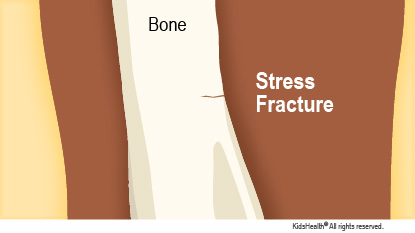A stress fracture is a tiny crack in a bone caused by repeating the same movement over and over. Most stress fractures heal within a few months with rest from the activity that caused it. Sometimes a cast, splint, brace, or boot is needed. Starting treatment right away is the best way to get kids back to full activity as quickly as possible. Follow these instructions as your child recovers.



Your child:

What causes stress fractures? Stress fractures usually happen from repeating the same movement over and over, such as when someone trains for a sport. For example, a gymnast may get a wrist stress fracture and a runner may get a foot stress fracture. Stress fractures also can happen from everyday activities in people whose bones are weak due to poor nutrition, eating disorders, or a medical condition. Stress fractures can take days or weeks to develop.
What are the symptoms of stress fractures? A stress fracture usually causes pain during activity. The pain may get better with rest at first, but then can become constant. A stress fracture may also cause tenderness and swelling.